Hp OMNIBOOK XE3-GE, OMNIBOOK XE3-GC, OMNIBOOK XE3-GF Startup Guide

HP Notebook PC
Startup Guide

Notice
This manual and any examples contained herein are provided “as is” and are subject to change without notice. Hewlett-Packard Company makes no warranty of any kind with regard to this manual, including, but not limited to, the implied warranties of merchantability and fitness for a particular purpose. Hewlett-Packard Co. shall not be liable for any errors or for incidental or consequential damages in connection with the furnishing, performance, or use of this manual or the examples herein.
Consumer transactions in Australia and the United Kingdom: The above disclaimers and limitations shall not apply to Consumer transactions in Australia and the United Kingdom and shall not affect the statutory rights of Consumers.
© Copyright Hewlett-Packard Company 2000. All rights reserved. Reproduction, adaptation, or translation of this manual is prohibited without prior written permission of Hewlett-Packard Company, except as allowed under the copyright laws.
The programs that control this product are copyrighted and all rights are reserved. Reproduction, adaptation, or translation of those programs without prior written permission of Hewlett-Packard Co. is also prohibited.
Portions of the programs that control this product may also be copyrighted by Microsoft Corporation, Phoenix Technologies, Ltd., ESS, S3 Incorporated, Accton, and Adobe Systems Incorporated. See the individual programs for additional copyright notices.
Microsoft, MS, MS-DOS, and Windows are registered trademarks of Microsoft Corporation. Pentium and the Intel Inside logo are U.S. registered trademarks and MMX is a U.S. trademark of Intel Corporation. Adobe and Acrobat are trademarks of Adobe Systems Incorporated.
Hewlett-Packard Company
Mobile Computing Division
19310 Pruneridge Ave.
Cupertino, CA 95014, U.S.A.
2 Startup Guide

HP Software Product License Agreement
Your notebook PC contains factory-installed software programs. Please read the Software License Agreement before proceeding.
Carefully read this License Agreement before proceeding to operate this equipment. Rights in the software are offered only on the condition that the customer agrees to all terms and conditions of the License Agreement. Proceeding to operate the equipment indicates your acceptance of these terms and conditions. If you do not agree with the terms of the License Agreement, you must now either remove the software from your hard disk drive and destroy the Recovery CD, or return the complete computer and software for a full refund.
Proceeding with configuration signifies your acceptance of the License Terms.
Unless otherwise stated below, this HP Software Product License Agreement shall govern the use of all software that is provided to you, the customer, as part of the HP computer product. It shall supersede any non-HP software license terms that may be found online, or in any documentation or other materials contained in the computer product packaging.
Note: Operating System Software by Microsoft is licensed to you under the Microsoft End User License Agreement (EULA).
The following License Terms govern the use of the software:
Use. Customer may use the software on any one computer. Customer may not network the software or otherwise use it on more than one computer. Customer may not reverse assemble or decompile the software unless authorized by law.
Copies and Adaptations. Customer may make copies or adaptations of the software (a) for archival purposes or (b) when copying or adaptation is an essential step in the use of the software with a computer so long as the copies and adaptations are used in no other manner.
Ownership. Customer agrees that he/she does not have any title or ownership of the software, other than ownership of the physical media. Customer acknowledges and agrees that the software is copyrighted and protected under the copyright laws. Customer acknowledges and agrees that the software may have been developed by a third party software supplier named in the copyright notices included with the software, who shall be authorized to hold the Customer responsible for any copyright infringement or violation of this Agreement.
Product Recovery CD-ROM. If your computer was shipped with a product recovery CD-ROM: (i) The product recovery CD-ROM and/or support utility software may be used only for restoring the hard disk of the HP computer with which the product recovery CD-ROM was originally provided. (ii) The use of any operating system software by Microsoft contained in any such product recovery CD-ROM shall be governed by the Microsoft End User License Agreement (EULA).
Startup Guide |
3 |

Transfer of Rights in Software. Customer may transfer rights in the software to a third party only as part of the transfer of all rights and only if Customer obtains the prior agreement of the third party to be bound by the terms of this License Agreement. Upon such a transfer, Customer agrees that his/her rights in the software are terminated and that he/she will either destroy his/her copies and adaptations or deliver them to the third party.
Sublicensing and Distribution. Customer may not lease, sublicense the software, or distribute copies or adaptations of the software to the public in physical media or by telecommunication without the prior written consent of Hewlett-Packard.
Termination. Hewlett-Packard may terminate this software license for failure to comply with any of these terms provided Hewlett-Packard has requested Customer to cure the failure and Customer has failed to do so within thirty (30) days of such notice.
Updates And Upgrades. Customer agrees that the software does not include updates and upgrades which may be available from Hewlett-Packard under a separate support agreement.
Export Clause. Customer agrees not to export or re-export the software or any copy or adaptation in violation of the U.S. Export Administration regulations or other applicable regulation.
U.S. Government Restricted Rights. Use, duplication, or disclosure by the U.S. Government is subject to restrictions as set forth in subparagraph (c)(1)(ii) of the Rights in Technical Data and Computer Software clause in DFARS 252.227-7013. HewlettPackard Company, 3000 Hanover Street, Palo Alto, CA 94304, U.S.A. Rights for nonDOD U.S. Government Departments and Agencies are as set forth in FAR 52.22719(c)(1,2).
Edition History
Edition 1 .............................................. |
July 2000 |
 This manual is printed on recycled paper.
This manual is printed on recycled paper.
4 Startup Guide

Contents |
|
Introducing Your Computer ........................................................................................... |
7 |
Taking Inventory .......................................................................................................... |
8 |
Software bundled on your computer ....................................................................... |
8 |
To find more information........................................................................................ |
9 |
Identifying Parts of the Notebook............................................................................... |
10 |
Top and right side view......................................................................................... |
10 |
Front view ............................................................................................................. |
11 |
Rear and left side view.......................................................................................... |
12 |
Bottom view.......................................................................................................... |
13 |
Status lights ........................................................................................................... |
14 |
Setting Up the Computer ............................................................................................ |
15 |
To install the battery ............................................................................................. |
15 |
To connect AC power ........................................................................................... |
16 |
To connect a phone line ........................................................................................ |
16 |
To turn on the computer........................................................................................ |
17 |
To set up Windows ............................................................................................... |
18 |
To register your computer..................................................................................... |
18 |
To reset your computer ......................................................................................... |
20 |
Using Your Computer .................................................................................................... |
21 |
Operating the Computer ............................................................................................. |
22 |
To use the Fn hot keys .......................................................................................... |
22 |
To use the touch pad ............................................................................................. |
22 |
Working in Comfort with a Notebook PC .................................................................. |
24 |
Traveling with Your Computer .................................................................................... |
27 |
Managing Power Consumption .................................................................................. |
28 |
To use manual power management....................................................................... |
28 |
Using Battery Power................................................................................................... |
30 |
To check the battery status.................................................................................... |
30 |
To respond to a low-battery warning .................................................................... |
31 |
Configuring and Expanding Your Computer.............................................................. |
33 |
Installing RAM modules............................................................................................. |
34 |
Removing RAM modules ........................................................................................... |
35 |
Expanding the hibernate partition............................................................................... |
36 |
Startup Guide |
5 |

Service and Support ....................................................................................................... |
37 |
Hewlett-Packard Limited Warranty Statement ........................................................... |
38 |
Getting Support for Your HP Notebook PC ............................................................... |
40 |
To use the Reference Guide .................................................................................. |
40 |
To get help from the HP notebook website........................................................... |
40 |
To call the HP Customer Care Center................................................................... |
41 |
Obtaining Repair Service............................................................................................ |
43 |
To receive warranty repair service ........................................................................ |
43 |
To prepare your computer for shipment ............................................................... |
43 |
Solving Problems with Your Computer ....................................................................... |
45 |
Troubleshooting Techniques ...................................................................................... |
46 |
Display problems .................................................................................................. |
46 |
Power and battery problems.................................................................................. |
47 |
Startup problems ................................................................................................... |
49 |
Standby and resume problems .............................................................................. |
50 |
Testing Hardware Operation....................................................................................... |
51 |
Recovering and Reinstalling Software ....................................................................... |
52 |
To recover the factory installation of your hard disk ............................................ |
52 |
Removing and Reinstalling the Hard Disk Drive ....................................................... |
53 |
If you decide to remove the hard disk drive.......................................................... |
53 |
To install the hard disk drive again ....................................................................... |
55 |
Specifications and Regulatory Information ................................................................. |
57 |
Hardware and Software Specifications....................................................................... |
58 |
Safety Information ...................................................................................................... |
59 |
Power Cords.......................................................................................................... |
59 |
Battery Safety........................................................................................................ |
60 |
Laser Safety........................................................................................................... |
61 |
LED Safety............................................................................................................ |
61 |
Regulatory Information .............................................................................................. |
62 |
U.S.A..................................................................................................................... |
62 |
Canada................................................................................................................... |
63 |
European Union .................................................................................................... |
63 |
Japan ..................................................................................................................... |
64 |
Russia .................................................................................................................... |
64 |
International .......................................................................................................... |
64 |
Index ................................................................................................................................ |
67 |
6 Startup Guide

Introducing Your Computer
Startup Guide |
7 |

Introducing Your Computer
Taking Inventory
Taking Inventory
Your HP notebook PC is shipped with these items:
•battery
•AC adapter and power cord
•Quick Start sheet
•HP notebook PC Startup Guide
•Recovery CD (or CDs), used to restore Windows and all software included with your computer
•Microsoft Windows manual (Windows 98 or Windows 2000)
•telephone cord (if your computer has a built-in modem)
Software bundled on your computer
Your HP notebook PC comes with preinstalled software, and various models are configured with different combinations of software. To see the list of software included with your computer, check HP Notes in the HP Library: click Start, Programs,
HP Library, HP Notes—or double-click the HP Notes icon on the desktop.
8 Startup Guide

Introducing Your Computer
Taking Inventory
To find more information
Here are some sources of information about your HP notebook PC.
Source
Quick Start sheet
Reference Guide
HP Notes
Introductory Microsoft manual for Windows
HP notebook PC website
Description
This pictorial inttroduction shows you how to get the computer up and running quickly.
The Reference Guide is a help file located on your hard drive. It provides you with detailed information about your notebook PC (Start, Programs, HP Library, Reference Guide).
This document contains late-breaking information available after the Reference Guide was completed (Start, Programs, HP Library,
HP Notes—or double-click the HP Notes icon on the desktop).
This manual contains information about using the standard features of Microsoft Windows (Windows 98 or Windows 2000, depending on which operating system your computer is shipped with).
www.hp.com/notebooks
Startup Guide |
9 |
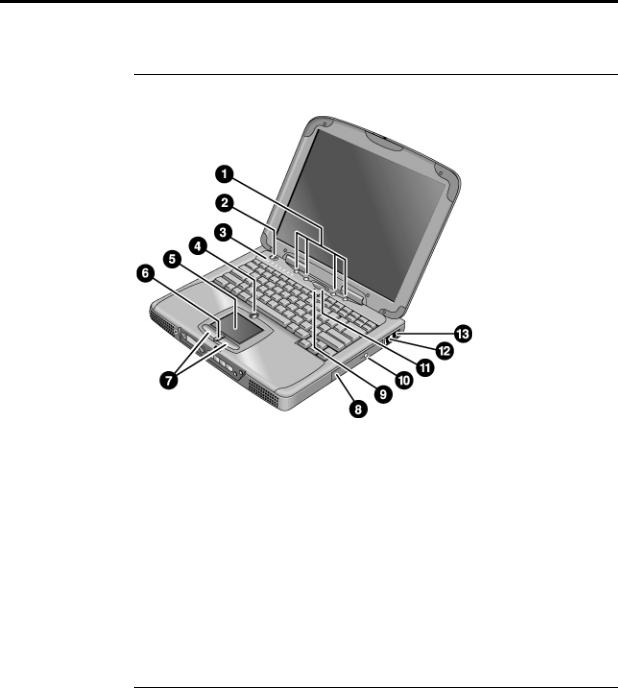
Introducing Your Computer
Identifying Parts of the Notebook
Identifying Parts of the Notebook
Top and right side view
1 |
One-Touch buttons |
8 |
CD-ROM drive or DVD |
2 |
Power switch |
9 |
Microphone |
3 |
Status lights (see “Status lights” on page 14) |
10 |
CD-ROM or DVD eject button |
4 |
Pad Lock touch pad on/off button |
11 |
Blue standby button |
5 |
Touch pad (pointing device) |
12 |
Modem port (on certain models) |
6 |
Scroll up/down toggle |
13 |
LAN port (networking— on certain models) |
7 |
Click buttons |
|
|
10 Startup Guide

Introducing Your Computer
Identifying Parts of the Notebook
Front view
14Headphone audio jack
15Status panel mode select button
16Status panel
17Multimedia buttons (see “Multimedia Buttons” in the
Reference Guide)
18Latch (to open computer)
Startup Guide |
11 |
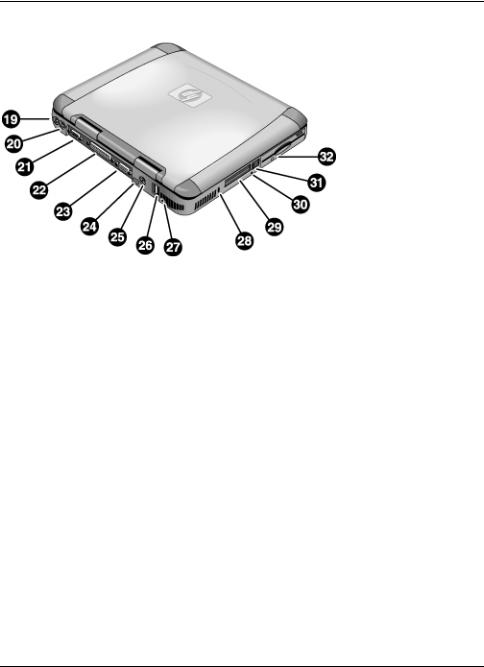
Introducing Your Computer
Identifying Parts of the Notebook
Rear and left side view
19 |
AC adapter (power) jack |
26 |
USB ports |
20 |
PS/2 port (external mouse or keyboard) |
27 |
Microphone jack |
21 |
Serial port |
28 |
Kensington lock slot (security connector) |
22 |
Parallel port |
29 |
PC card slots |
23 |
VGA port (external monitor) |
30 |
System-off button (for resetting computer) |
24 |
Infrared port |
31 |
PC card eject buttons |
25 |
TV output port |
32 |
Floppy disk drive |
12 Startup Guide
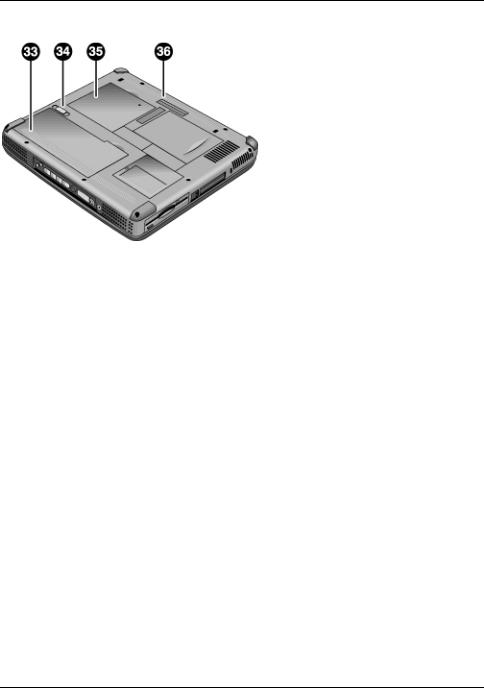
Introducing Your Computer
Identifying Parts of the Notebook
Bottom view
33Battery
34Battery latch
35RAM expansion cover
36Port replicator (docking) connector
Startup Guide |
13 |
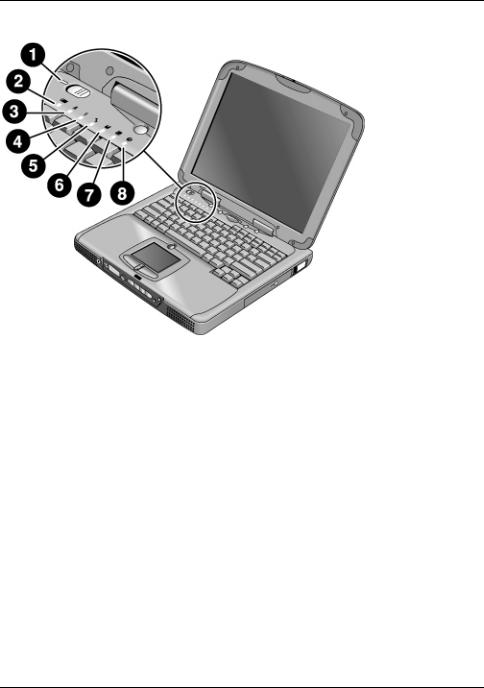
Introducing Your Computer
Identifying Parts of the Notebook
Status lights
1Power
2Battery
3Caps lock (capital letters)
4Num lock (numeric keypad)
5Scroll lock
6Floppy disk drive access
7Hard disk drive access
8CD-ROM drive or DVD access
14 Startup Guide
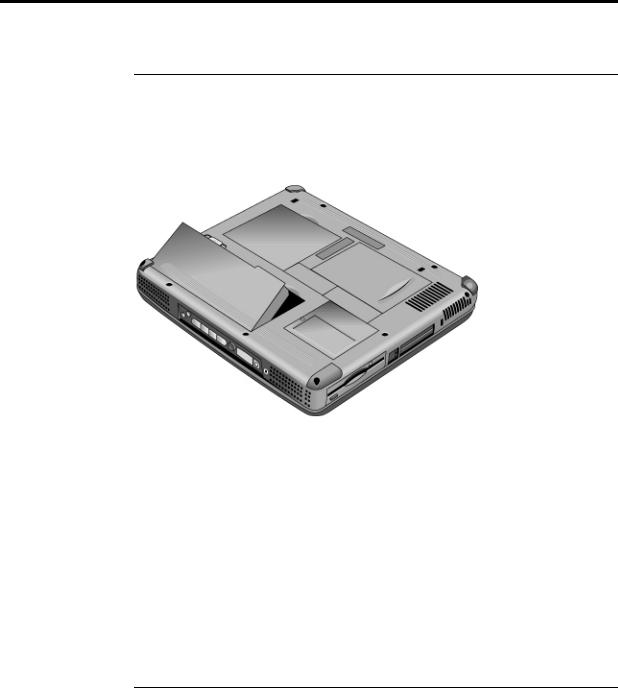
Introducing Your Computer
Setting Up the Computer
Setting Up the Computer
To install the battery
Your computer is shipped with the battery installed. If the battery has been removed, you can install it by inserting it into the battery bay on the bottom of your computer. Insert the back edge first, as shown, then press down the front edge until the battery latch clicks shut.
|
Once you have installed the battery, connect the AC adapter to the computer and |
|
recharge the battery while you work. You can also replace a low battery with another that |
|
is more fully charged. |
|
|
WARNING |
Do not mutilate, puncture, or dispose of batteries in fire. A battery can burst or |
|
explode, releasing hazardous chemicals. A rechargeable battery must be recycled |
|
or disposed of properly. |
|
|
Startup Guide |
15 |
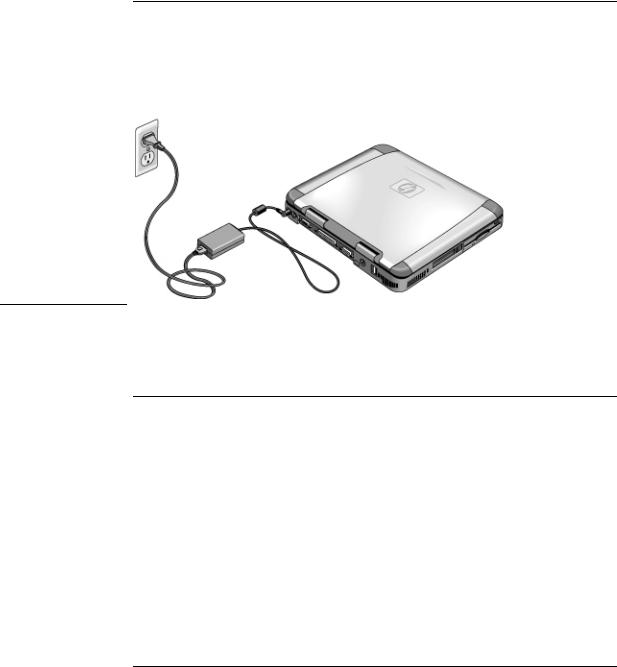
Introducing Your Computer
Setting Up the Computer
To connect AC power
Plug in the AC adapter, then connect the AC adapter to the rear of the computer. The battery starts charging.
CAUTION |
Use only an HP AC adapter intended for this product, either the adapter that came |
|
with the computer or another authorized HP adapter. Using an unauthorized AC |
|
adapter can damage the computer and may void your warranty. Refer to the |
|
warranty statement for your product. |
|
|
To connect a phone line
Selected models of the HP notebook PC include a built-in modem. If you prefer, you can instead use a PC card modem or an external modem to connect a phone line.
16 Startup Guide
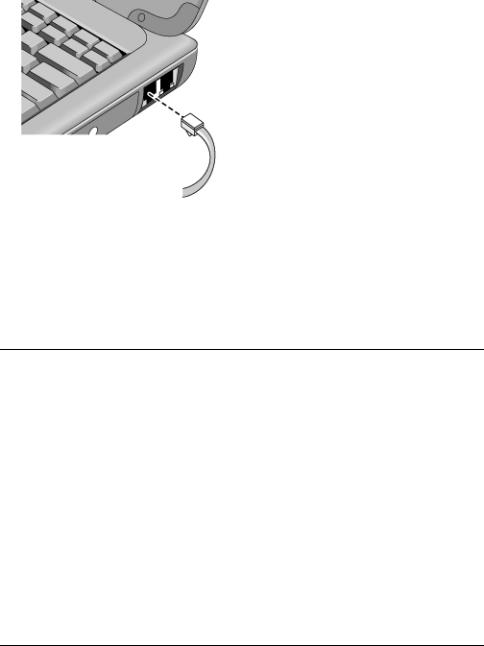
Introducing Your Computer
Setting Up the Computer
1.Plug one end of the phone line into the modem phone jack on the computer. Be sure it clicks into place.
|
2. Plug the other end of the phone line into a telephone jack. (If the phone line does not |
|
fit your telephone jack, you may need to use an adapter.) |
|
|
CAUTION |
Your built-in modem may not work with multiple phone lines or a private branch |
|
exchange (PBX), cannot be connected to a coin-operated telephone, and does not |
|
work with party lines. Some of these connections may result in excess electrical |
|
voltage and could cause a malfunction in the internal modem. Check your |
|
telephone line type prior to connecting your phone line. |
|
|
To turn on the computer
Slide the power switch to the left—it’s the control above the left side of the keyboard. Windows starts automatically. If you are turning on the computer for the first time, go to “To set up Windows” on page 18.
The power status light next to the power switch (see “Status lights” on page 14) reports the following:
• steady green light: computer is on
• steady amber light: computer is in system standby (or suspend) mode
• no light: computer is off or in hibernate mode
See “Managing Power Consumption” on page 28 for additional information about turning off your computer.
Startup Guide |
17 |

Hint
Note
Introducing Your Computer
Setting Up the Computer
If your computer does not turn on when operating on battery power, the battery may be out of power. Plug in the AC adapter and slide the power switch to the left again.
To set up Windows
Your HP notebook has Microsoft Windows—either Windows 98 or Windows 2000— preinstalled on the hard disk drive. The first time you turn on your computer, a Windows Setup program will automatically run so that you can customize your setup.
Before you begin, connect the AC adapter to your notebook, since your battery may not be sufficiently charged to complete the Windows setup. Also, be sure to connect the notebook to a phone line; see “To connect a phone line” on page 16.
1.Slide the power switch to the left.
2.The Windows Setup program starts automatically.
3.Follow the instructions as they appear on the screen. During setup, you are prompted to:
•enter a user name
•accept the License Agreement
You can also register your computer at this time. Follow the instructions on the screen during setup, or—if registration does not occur during setup—double-click the HP Notebook Registration icon on the desktop.
You may be required to enter your Windows ID number. To locate it, look on the Certificate of Authenticity packaged with the Microsoft Windows manual or look for a sticker in the battery compartment.
If you have any connection problems with your modem, try redialing. If that doesn’t work, you can skip registration for now.
To register your computer
Be sure to register your computer. Registering is free and fast, and it ensures you will receive quicker, more personalized support. The information you provide during registration will be used to provide you with better products and services.
18 Startup Guide

Introducing Your Computer
Setting Up the Computer
There are three ways to register:
•by modem
•by phone
•by fax
By modem
If you have Windows 98, you are prompted automatically to register. To register by modem, see that the phone is connected, then follow the onscreen instructions.
If you have Windows 2000, you are not prompted to register, but you can register by modem if you double-click the HP Notebook Registration icon on the desktop or click the Register link in the Windows 2000 welcome screen. See that the phone line is connected and follow the onscreen instructions.
With either operating system, if you choose not to register right away, you can register by modem later by double-clicking the Registration icon on the desktop. This icon disappears after you register.
If your computer does not have a built-in modem, you can register after you set up a PC card modem or an external modem—or you can register by phone or fax.
By phone
You can call your HP Customer Care Center and register by phone. Check “To call the HP Customer Care Center” on page 41 for the phone number.
By fax
If a printer is connected to your computer, you can print a copy of your registration and fax it to HP. You will find the fax number on the registration form.
By completing registration, you will:
•Record your ownership of the computer with Hewlett-Packard and gain access to service, support, and information.
•Record your ownership of the Windows 98 operating system with Microsoft. If you have Windows 2000, please contact Microsoft separately for registration of the operating system.
Startup Guide |
19 |

Introducing Your Computer
Setting Up the Computer
To reset your computer
If Windows or your computer stops responding, you can reset the computer and restart Windows.
1.If possible, shut down Windows (Start, Shut Down, Shut down, OK).
2.If the computer does not shut down, slide and hold the power switch for five seconds, then release it.
3.If the computer still does not shut down, insert a pin or straightened paper clip into the recess on the left side of the computer, underneath the PC card eject buttons.
4.After the computer shuts down, slide the power switch and release it to turn the computer on again.
20 Startup Guide

Using Your Computer
Startup Guide |
21 |
